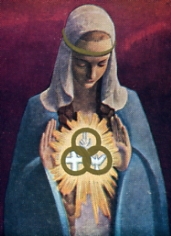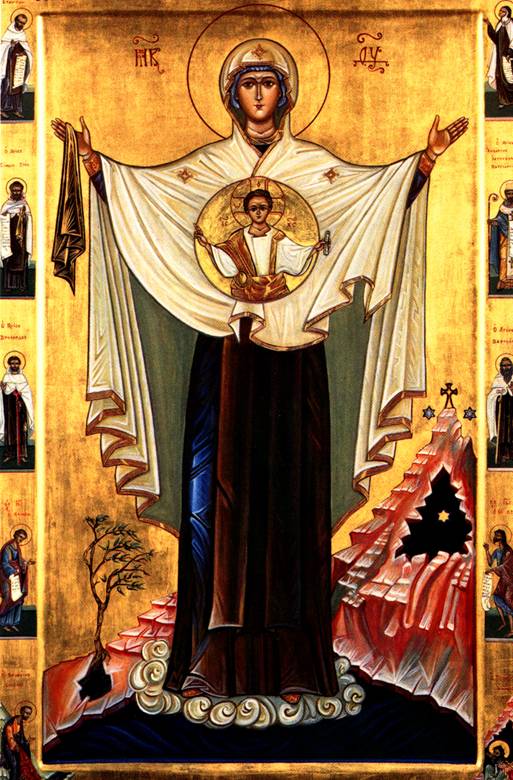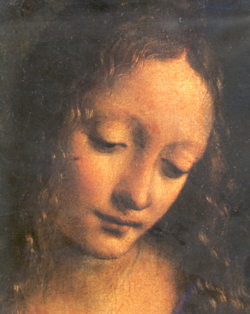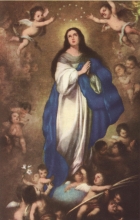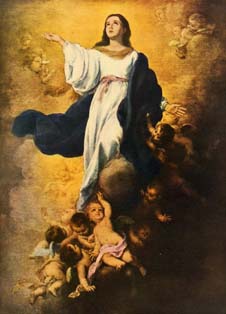Overview of Marian Dogmas
Overview of Marian Dogmas
– Father Johann Roten, S.M.
MARIAN DOGMAS - AN OVERVIEW
This section deals with three important concerns:
I. Mary can be understood only in concert with Jesus Christ, the Trinity, and the Church
II. The most important features of Mary's role and person are captured in the four Marian dogmas
III. The Marian dogmas have a rich meaning for our spiritual life
I. Mary can be understood only in concert with Jesus Christ, the Trinity, and the Church
1. Mary's importance lies in her relation to Christ
- Jesus Christ is "born of a woman" (Gal 4,4). Mary is this woman (Read article 422 of the Catechism of the Catholic Church [CCC]).
- Jesus Christ was born a Jew of a "maid of Israel" (read CCC 423).
- Mary is a Jewish woman.
- Jesus Christ is "true God and true Man" (Read CCC 471-483). Mary is true Mother of God (Theotokos) according to his humanity.
- Jesus Christ was conceived by the Holy Spirit, and was born of the Virgin Mary (Read CCC 484-512). Mary is all-holy and sinless (Immaculate Conception). She is the virginal mother (Ever-Virgin).
2. Mary manifests the presence and action of the Holy trinity, especially that of the Holy Spirit. She is the masterpiece and dwelling place of Father, Son and Spirit. Thus, she is called Seat of Wisdom (read CCC 721-726)
3. Mary is not only Mother of Christ, but also Mother of the Church (Read CCC 963-975). Totally united to her Son, in her life and her assumption, she becomes our mother as the work of grace. She is a model of faith, hope and charity.
II. The most important features of Mary's role and person are captured in the four Marian dogmas
1. What are dogmas?
It is important to have a positive understanding of dogma:
- A dogma proposes truths contained in Divine Revelation or having a necessary connection with it.
- These truths are immediately or mediately grounded in Scripture.
- They reflect not only the full authority of the Church received from Christ but also the Church's tradition, liturgical practice and the faith of the people (sensus fidelium).
- Dogmas are lights on our path of faith. They have binding character, and intellect and heart to a deeper understanding of God's mystery. Read CCC 88-89 (85-95).
There are four dogmas stating important aspects of Mary's role in salvation and her personal relationship with God. Their names are:
DIVINE MOTHERHOOD (Ephesus 431)
Various names are used to describe Mary's role as mother of Jesus. She is called "Mother of God" which translates the more accurately stated "Theotokos" or Birthgiver of God.
The Council of Ephesus (431) attributed to Mary the title, Mother of God. This needs to be read against the Council's declaration that in Christ there are two natures, one divine and one human, but only one person. Indeed, according to the Council the holy virgin is the Mother of God since she begot according to the flesh the Word of God made flesh. This normative decision was further explicated by the Council of Chalcedon (451) which says with regard to Mary's divine motherhood:
"...begotten from the Father before the ages as regards his godhead, and in the last days, the same, because of us and because of our salvation begotten from the Virgin Mary, the Theotokos, as regards his manhood; one and the same Christ, Son, Lord, only-begotten..."
In short, Mary's Divine Motherhood was not the object of an independent or exclusive dogmatic declaration. The statement is embedded in texts defining the person and natures of Jesus Christ. Thus, the dogma of Divine Motherhood becomes an integral part of the christological dogma. This does not diminish its definitive and binding character. The dogma of Divine Motherhood is generally accepted by all Christian denominations.
Papal documents on the pronouncement of the dogma:
- Lux Veritatis: on the Council of Ephesus, Encyclical of Pope Pius XI promulgated on December 25, 1931
PERPETUAL VIRGINITY (Baptismal formula; since third century)
The expression perpetual virginity, ever-virgin, or simply "Mary the Virgin" refers primarily to the conception and birth of Jesus. From the first formulations of faith, especially in baptismal formulas or professions of faith, the Church professed that Jesus Christ was conceived without human seed by the power of the Holy Spirit only. Here lies the decisive meaning of expressions such as "conceived in the womb of the Virgin Mary," "Mary's virginal conception," or "virgin birth." The early baptismal formula (since the third century) states Mary's virginity without further explaining it, but there is no doubt about its physical meaning. Later statements are more explicit. Mary conceived "without any detriment to her virginity, which remained inviolate even after his birth" (Council of the Lateran, 649).
Although never explicated in detail, the Catholic Church holds as dogma that Mary was and is Virgin before, in and after Christ's birth. It stresses thus the radical novelty of the Incarnation and Mary's no less radical and exclusive dedication to her mission as mother of her Son, Jesus Christ. Vatican II reiterated the teaching about Mary, the Ever-Virgin, by stating that Christ's birth did not diminish Mary's virginal integrity but sanctified it (LG 57). The Catechism of the Catholic Church ponders the deeper meaning of the virgin bride and perpetual virginity (Read CCC 499-507). It also maintains that Jesus Christ was Mary's only child. The so-called "brothers and sisters" are close relations.
IMMACULATE CONCEPTION (Pius IX, December 8, 1854)
Esteban Murillo
Immaculate Conception
Church of S.Philip Neri
Cadiz, Spain
The solemn definition of Mary's Immaculate Conception is like Divine Motherhood and Perpetual Virginity part of the christological doctrine, but it was proclaimed as independent dogma. Though highlighting a privilege of Mary it in fact stresses the dignity and holiness required to become "Mother of God." The privilege of the Immaculate Conception is the source and basis for Mary's all-holiness as Mother of God.
More specifically, the dogma of the Immaculate Conception states "that the most Blessed Virgin Mary, from the first moment of her conception, by a singular grace and privilege from Almighty God and in view of the merits of Jesus Christ, was kept free of every stain of original sin."
This dogmas has both a "negative" and a "positive" meaning which complement each other. The "negative" meaning stresses Mary's freedom from original sin thanks to the anticipated or retroactive (here called preventive) grace of Christ's redemptive act. By the same token, the dogma suggests Mary's all-holiness. This "positive" meaning is the consequence of the absence of original sin. Mary's life is permanently and intimately related to God, and thus she is the all-holy.
Although difficult to explain, original sin provokes disorderliness in thought and behavior, especially with regard to the primacy of God's presence in our life. Consequently, in declaring Mary immaculately conceived, the Church sees in Mary one who never denied God the least sign of love. The dogmas declares that from her beginning Mary was exceptionally holy and in constant union with the sanctifying grace of the Holy Spirit.
Papal documents on the pronouncement of the dogma:
- Apostolic Constitution issued by Pope Pius IX on December 8, 1854
- Ad Diem Illum Laetissimum: On the Immaculate Conception, Encyclical of Pope Pius X promulgated on February 2, 1904
ASSUMPTION (Pius XII, November 1, 1950)
A distinction needs to be made between Ascension and Assumption. Jesus Christ, Son of God and Risen Lord, ascended into heaven, a sign of divine power. Mary, on the contrary, was elevated or assumed into heaven by the power and grace of God.
The dogmas states that "Mary, Immaculate Mother of God ever Virgin, after finishing the course of her life on earth, was taken up in body and soul to heavenly glory." This definition as well as that of the Immaculate Conception makes not only reference to the universal, certain and firm consent of the Magisterium but makes allusion to the concordant belief of the faithful. The Assumption had been a part of the Church's spiritual and doctrinal patrimony for centuries. It had been part of theological reflection but also of the liturgy and was part of the sense of the faithful.
This dogma has no direct basis in scripture. It was nonetheless declared "divinely revealed," meaning that it is contained implicitly in divine Revelation. It may be understood as the logical conclusion of Mary's vocation on earth, and the way she lived her life in union with God and her mission. The assumption may be seen as a consequence of Divine Motherhood. Being through, with, and for her Son on earth, it would seem fitting for Mary to be through, with, and for her Son in heaven, too. She was on earth the generous associate of her Son (LG 61). The Assumption tells us that this association continues in heaven. Mary is indissolubly linked to her Son on earth and in heaven. (LG 56).
In heaven, Mary's active involvement in salvation history continues: "Taken up to heaven, she did not lay aside her salvific duty ... By her maternal love she cares for the brothers and sisters of her Son who still journey on earth" (LG). Mary is the "eschatological icon of the Church" (CCC 972), meaning the Church contemplates in Mary her own end of times.
The definition of the dogma does not say how the transition from Mary's earthly state to her heavenly state happened. Did Mary die? Was she assumed to heaven without prior separation of soul and body? The question remains open for discussion. However, the opinion that Mary passed through death as her Son did, has the stronger support in tradition.
- Glorified in body and soul, Mary is already in the state that will be ours after the resurrection of the dead. The Assumption of Mary is a promise of immortality for all human beings. The Assumption highlights the unity of body and soul, their respective dignity and fulfillment.
Are the four Marian dogmas grounded in Scripture? One of the criticisms voiced on behalf of the Marian dogmas is their lack of biblical foundation. This criticism does not apply in the case of Mary's Divine Motherhood and Virginity, even if every single aspect of these dogmas cannot be substantiated from Scripture. As noticed for the Assumption, the biblical foundation of the two modern dogmas is more difficult to establish. There is no explicit reference to Immaculate Conception and Assumption in Scripture. Elements of the two dogmas are implicitly contained in the Bible.
Papal documents on the pronouncement of the dogma:
- Encyclical Munificentissimus Deus by Pope Pius XII
Defining "ex cathedra" (from the chair of Peter) the dogma of the Assumption of the Blessed Virgin
- Mary and the Church: Assumption (eschatological image) (A list of quotations on the Assumption from post-Vatican II magisterial documents
III. The Marian dogmas have a rich meaning for our spiritual life
1. For a better understanding of Mary
The four dogmas help us distinguish between person and role in the life of Mary. They give us a better understanding of who she is in the eyes of God.
- As we can see there are two early dogmas highlighting Mary's role in the Incarnation: Divine Motherhood and Perpetual Virginity.
- There are two modern dogmas closely affecting Mary's person: The Immaculate Conception and Mary's Assumption into Heaven.
- The four dogmas show that Mary's role in the Incarnation as Mother (humanity of Jesus Christ) and Virgin (divinity of Jesus Christ) was first. The interest in her person (Immaculate Conception and Assumption) came later. All four dogmas stress Mary's unique relationship with God.
2. For a better understanding of Jesus Christ
Divine motherhood and perpetual virginity ascertain and deepen our understanding of Jesus Christ. They contribute to answering the question: Who is Jesus Christ? Jesus Christ is true God (Mary's virginity) and true man (Mary's role as Theotokos).
Immaculate Conception and Assumption point out how we are to follow Jesus Christ. Following Christ means to be called and predestined/commissioned (Immaculate Conception), and thus to lead a God-pleasing life based on his grace (Assumption).
Mother of the Church (Mary's mediation and spiritual motherhood)–although not a solemnly defined truth (dogma)–highlights the importance of ecclesial community. We follow Christ as members of his Church. Mary is not only mother but also sister in the faith.
3. For a better understanding of our own life
Marian dogmas have a special meaning for our self-understanding as human beings created in the image and likeness of God.
- Mary's divine motherhood reminds us that God is the origin of life and life's fulfillment, and that it is in him that we are called to bear fruit.
- Mary's virginity reminds us that human fulfillment and authentic efficacy is rooted in the gift of self.
- Mary's Immaculate Conception reminds us that we are called to the highest possible and most intimate and lasting unity with God
- Mary's assumption is promise of ultimate and everlasting fulfillment in God.
4. The Church has a rich memory of Mary's ongoing role and active presence
The teaching about Mary (we call it doctrine) is not limited to the four dogmas. Much of the Church's theological thinking about Mary has never been the object of a solemn dogmatic declaration. It doesn't need to be; for example, we firmly believe that Mary was the first disciple of Jesus Christ, our sister in faith, and an associate in her Son's mission. None of these beliefs are dogmas. Similarly, we believe that Mary is our mother, in fact, a spiritual mother. Vatican II, Chapter 8, summarizes most of the aspects of Mary's activity on our behalf with the expressions "Mother of the Faithful" and "Mother of Human Beings."
5. Jesus Christ gave Mary as mother to the beloved disciple (Jn 19, 25-27).
Thus, she becomes the mother of all of Christ's disciples, indeed, of all human beings. Mary's motherhood for us has its root in her service to Jesus our Savior. Here is what the second Vatican Council; Lumen Gentium, had to say about this:
- 61. The predestination of the Blessed Virgin as Mother of God was associated with the incarnation of the divine word: in the designs of divine Providence she was the gracious mother of the divine Redeemer here on earth, and above all others and in a singular way the generous associate and humble handmaid of the Lord. She conceived, brought forth, and nourished Christ, she presented him to the Father in the temple, shared her Son's sufferings as he died on the cross. Thus, in a wholly singular way she cooperated by her obedience, faith, hope and burning charity in the work of the Saviour in restoring supernatural life to souls. For this reason she is a mother to us in the order of grace.
We are speaking about a spiritual motherhood. This means that Mary's maternal activity is to unite us with Christ who is our life, truth and being. Several spiritual authors have used the expression "forming Jesus Christ in us" or "forming us in the likeness of her Son."
Mary, although called "mother in the order of grace," is not the author of grace. Her "spiritual motherhood" is the power of salvation (LG 60). Mary brought forth her Son in the power of the Spirit. It is in and through this same Holy Spirit that she exercises her maternal presence and activity on our behalf.
by Fr. Johann G. Roten, S.M.
All About Mary includes a variety of content, much of which reflects the expertise, interpretations and opinions of the individual authors and not necessarily of the Marian Library or the University of Dayton. Please share feedback or suggestions with marianlibrary@udayton.edu.

